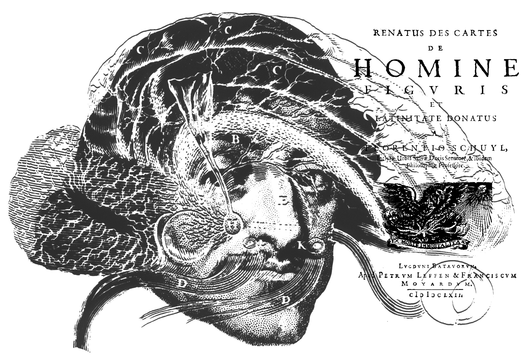René Descartes1596–1650
Representations of Descartes’ treatment of the brain were produced after his death. The one shown, in which his portrait is embedded, is taken from the Latin version of On Man, the title page of which is also shown. A number of similar illustrations from De Homine all depict one eye only, whereas their corresponding figures from the Traité de l’Homme, published two years later, display two. It would seem that the illustration has played a greater role in historical interpretations than the text from which it was derived, and the credit should be placed with the artist as well as Descartes. It is particularly significant in this case because neither of the series of diagrams was produced by the author of the text. The Traité first appeared over a decade after his death, and two separate versions of it were printed. The first, in 1662, was translated into Latin (De Homine) and illustrated by Florentius Schuyl, who is said to have worked from a defective manuscript copy of the French. The French version appeared in 1664: the text was given to two illustrators (Gerard van Gutschoven and Louis de la Forge), who each made a complete set of drawings independently of the other; van Gutschoven’s were the ones most generally printed, though some of La Forge’s were included, too. The whole set of la Forge’s illustrations can be found in the Latin edition of 1677. Descartes’ philosophy involved searching for new methods of enquiry rather than adopting those of past philosophers. His method was to reject all ideas about which there could be any doubt. That is, his sceptical enquiries led him to the view that only thought and reason were beyond doubt; they were the foundations upon which philosophy should be built and they were the province of humans alone. The body, on the other hand, worked by mechanical principles the understanding of which Descartes did much to advance, particularly in the context of vision. Thus, Descartes gave to the mind properties that were not shared by the body, which was treated as a machine. His mechanistic approach to the senses clarified many issues in perception, but he had to grasp the thorny problem of accounting for the interaction of the rational mind with the mechanistic body. Communion between mind and body was achieved via structures in the brain, particularly the unpaired pineal body (the pear-shaped structure labeled H in the illustration). Descartes saw the senses as means of understanding the mind, and he made many astute observations and interpretations of their functions. These included phantom limbs, colour vision, and perceptual constancy. His interests in visual acuity were driven by the difficulties in distinguishing between single and multiple stars, either by the naked eye or with the assistance of a telescope. He assigned the limits of visual resolution to the dimensions of the receptive fibres in the retina. Receptors were not known about at that time, and Descartes assumed that the retina consisted of the endings of the fibres of the optic nerve. Since these were of a particular size, Descartes argued that no object smaller than a fibre could be resolved. His correspondent, Marin Mersenne (1588-1648), stated that a grain of sand could be seen from a distance of 10 or 12 feet and calculated that it subtended an angle of 15” at the eye.
